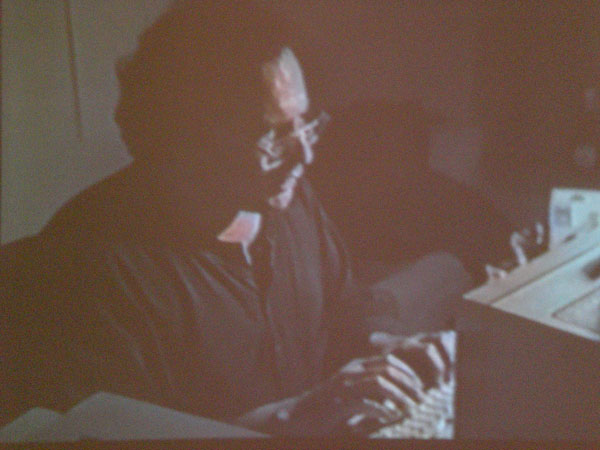
Steve Gerber must have felt like a pariah in the comic book business. It became difficult for him to scrounge up work. "I wasn't exactly blackballed from comics, but work was getting sparse, and I had to find something else to do." Fortunately, Mark Evanier hired him to write stories for Marvel's Hanna-Barbera line of comics for their overseas publications, using the pseudonym Reg Everbest, an anagram of Steve Gerber's name. "An editor at the company had loudly vowed that the work of Steve Gerber would never again appear in anything published by Marvel," Evanier recalled. "Just to be ornery, we immediately had Steve write a story for one of the H-B comics I was editing..." It was a new experience for Gerber: "I was working on characters like Jabberjaw, Hong Kong Phooey, even Scooby-Doo, and having to tell a complete story in six pages."
Evanier also brought Gerber to Ruby-Spears Productions, where he began a career in animation. "After I'd done a couple of Plastic Man episodes there, I brought the THUNDARR idea to Joe Ruby, and that ultimately led to a staff position and then my whole second career in animation. Mark also developed and wrote the pilot for Dungeons and Dragons. For reasons I don't recall, he didn't want to story edit the show, so I moved over to Marvel Productions -- while the lawsuit was still going on! -- and took the reins on that show."
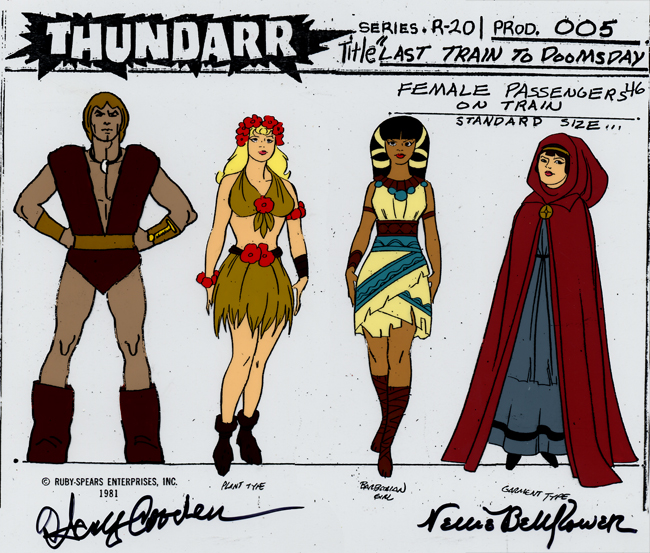
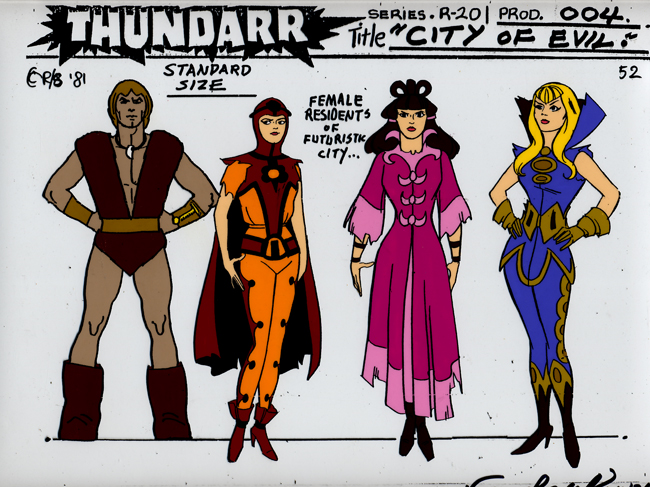
Gerber found writing dialogue for animation to be quite different from comic books. "It's easier to write a real exchange between characters for TV or film, with one character speaking, then the other, then the first again, then the other again. In comics, that's extremely difficult, because the balloon placement becomes a nightmare."
Then, of course, the working process was even more frustrating: "The final product often bears little or no resemblance to what the writer puts on the page. By the time a film or TV show gets to the screen, the writer has collaborated with literally hundreds of people, and a little of the original vision has gotten lost at each step between script and finished product. The writer writes, and then everybody else; the story editors, directors, producers, network executives, censors, actors in live action, storyboard artist in animation, gets to have 'input.'" He called the final product a "bastardized version." "The only thing that's really better about working in TV than comics is the money..."
Gerber griped that the Programs Practices people wouldn't allow his barbarian, Thundarr, "to punch or to hit anybody. He can do all sorts of acrobatic things, but he can't even trip anyone. We had to design a sword which was not a sharp object, which naturally led people to a laser sword. However, that had already been done before so we had to take it one step further to a lightning sword." Thundarr was emasculated.
While at Ruby-Spears Gerber also wrote some episodes of GOLDIE GOLD (a Richie Rich rip-off), ACTION JACK and Mr. T. He also wrote YU-GI-OH! for 4Kids Entertainment and later served as the story editor on G.I. JOE at Sunbow Productions, and TRANSFORMERS for Marvel. Although Gerber would recall his work on G.I. Joe with some amount of pride, his animation period seems to have otherwise been bleak. He later summed up Saturday morning cartoons of the early 1980s as being as "boring as cartoons ever got."
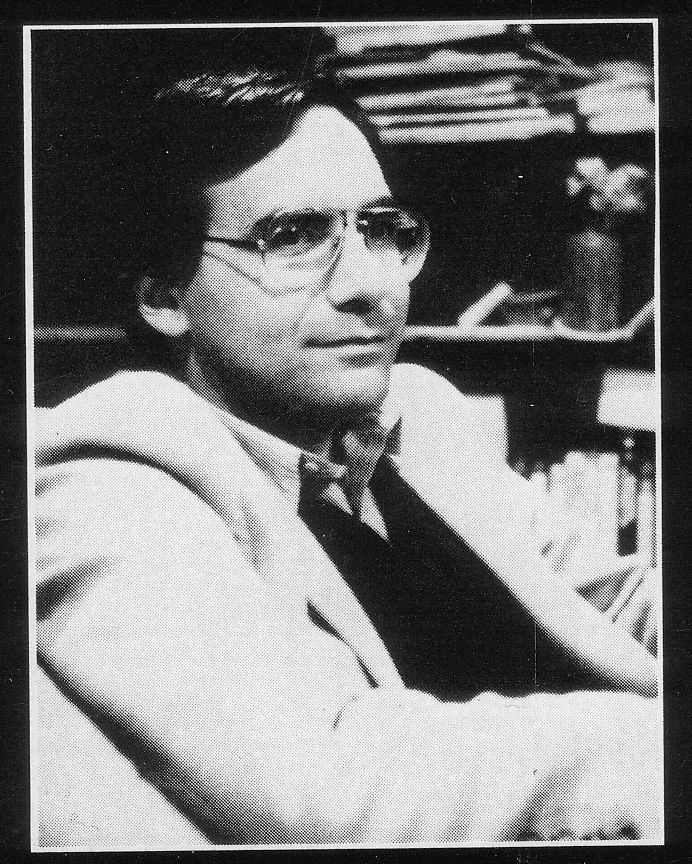
In November 1980, Gerber's graphic novel STEWART THE RAT was published by Jan and Dean Mullaney's Eclipse Enterprises. "I had been friends with Dean Mullaney for a number of years before he and his brother Jan started Eclipse. After I left Marvel in 1978, Dean wanted to do a book with me. The rat idea was, I suppose, a natural follow-up to the duck. Looking back, I consider it a mistake; I should have done something else, something radically different, first. At the time, though, the temptation to do a reverse-Disney -- first a duck, then rodent -- was irresistible." Gene Colan, whom Gerber held in great esteem, provided the art, with his frequent collaborator Tom Palmer inking.
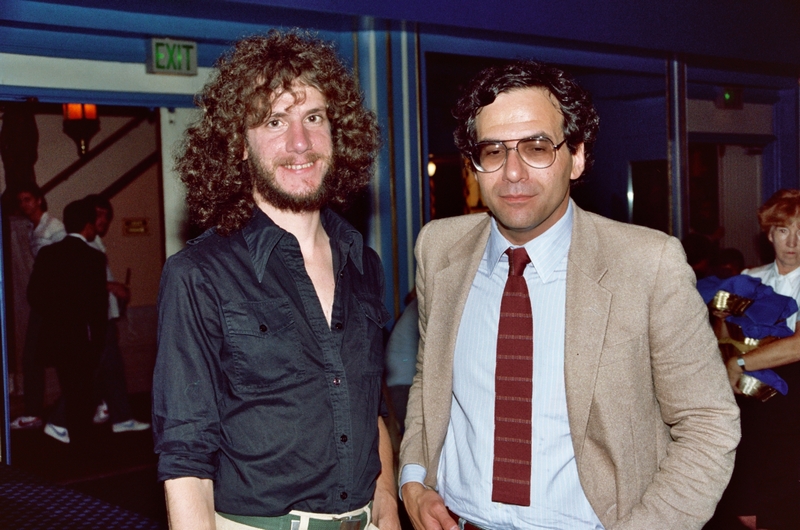
In 1982, Eclipse published Gerber's ground-breaking "Special Lawsuit Benefit Edition" comic book DESTROYER DUCK, which he described as "a satire on Howard and the whole work-for-hire business."
"Lawsuits are expensive. At one point, it looked like I was going to have to pack up my briefs and chuck the whole thing, until I came up with the idea of publishing a comic book to help finance the suit. That comic book was DESTROYER DUCK #1."
Gerber was willing to work for free, but he didn't think anybody else would be. Somehow he dredged up the temerity to approach the great Jack Kirby to illustrate the book -- 20 pages without pay! "This is not something you do everyday." Gerber and Kirby were already acquainted, since both men were working together at Ruby-Spears. "I was working on THUNDARR THE BARBARIAN at the time and Jack had been brought in to do some production sketches for the series."
To Gerber, Kirby seemed the obvious choice to draw the comic "because of his history with Marvel." But he understandably had qualms. "I was so terrified that I had to take Mark Evanier with me out to Jack's house for moral support. We went out there and sat down in the living room. Roz [Kirby's wife] brought us coffee and cookies and all the usual stuff. I sat there, pouring sweat, and explained about the lawsuit. Every time I started to 'hem' and 'haw,' Mark leaped in."
After beating around the bush Gerber eventually explained "how it was going to prevent me from going to debtor's prison, and Mark explained about the lawsuit, and then we got to the Big Question: Would you draw it...for free? And I have to tell you that my voice went up about three octaves with the words 'for free.' Without skipping a beat, he said, 'Sure, sounds like fun.' He wasn't even fazed by it."
Aside from Gerber, Kirby and inker Alfredo Alcala (who was at Ruby-Spears, inking Kirby's sketches) on the main feature, the comic also contained contributions by MAD's Sergio Aragones (Aragones showed Gerber and Evanier a drawer full of material and told them to take anything they wanted, and so "Groo the Wanderer" made his debut), NATIONAL LAMPOON's Shary Flenniken ("The Adventures of Thelma Ironthighs"), Mark Evanier, Dan Spiegel, Martin Pasko, Joe Staton, Scott Shaw, Gordon Kent, Connie Dobbs, Steve Leialoha and Tom Orzechowski, all performing a service gratis.
As Gerber stated in DESTROYER DUCK: "All of the publisher's profits from this magazine go to support my legal efforts to establish my ownership of Howard the Duck. Nobody's making a nickel on this comic book, except your comics dealer, his distributor, and the printer. That's unprecedented...at least when it occurs intentionally."
Gerber was "flattered" that he was one of the few writers to ever work with Kirby. Kirby had worked mainly with Stan Lee until 1970, at which time he'd struck a deal with DC to start his own line of comics, which he also wrote and edited. He made a similar deal with Marvel when he returned in 1975. Trouble began when Kirby insisted that all of his original art be returned to him. Before 1975 the Marvel "vault" was an unsecured, dilapidated warehouse with stacks of unsorted and uncatalogued art toppled over onto the floor and spilling from shelves that were teetering on the edge of disaster. There was nothing predating 1960, but in the ten years from 1960 to 1970 Kirby had drawn over 8600 pages for Marvel. After organizing and archiving the material in the warehouse, it was discovered that only 88 of Kirby's pages were left -- a mere 1%. The rest were unaccounted for, but much of it was being sold on the collector's market. Marvel wouldn't return the 88 pages unless Kirby signed a release form which contained far too many offensive stipulations to get into here. Kirby says the four-page release was "almost like a contract," but that he would have gladly signed the regular release sent to other artists, and there would have been an end to it.
DESTROYER DUCK must have been a revenge fantasy for Kirby. The cover of the first issue is vicious: The Marauding Mallard of Vengeance bursts into a board room and hops onto the table, his machine gun sweeping the room and blasting someone in the face so that his dentures fly out; his other hand is holding a grenade and he's pulling the pin with his teeth. We can see four others lying dead, one of whom has three bullet holes in his balding pate.
Originally, the comic was intended to be a one-shot, as Gerber and Kirby were both working full-time in animation and neither had time to do a regular series. "But," said Gerber, "Dean Mullaney told me that the retailers he'd spoken to were very wary of a one-shot. They felt that it had to be a series or their customers wouldn't be interested, and, of course, the retailers would order accordingly. So we said, 'Okay, it's a series.'"
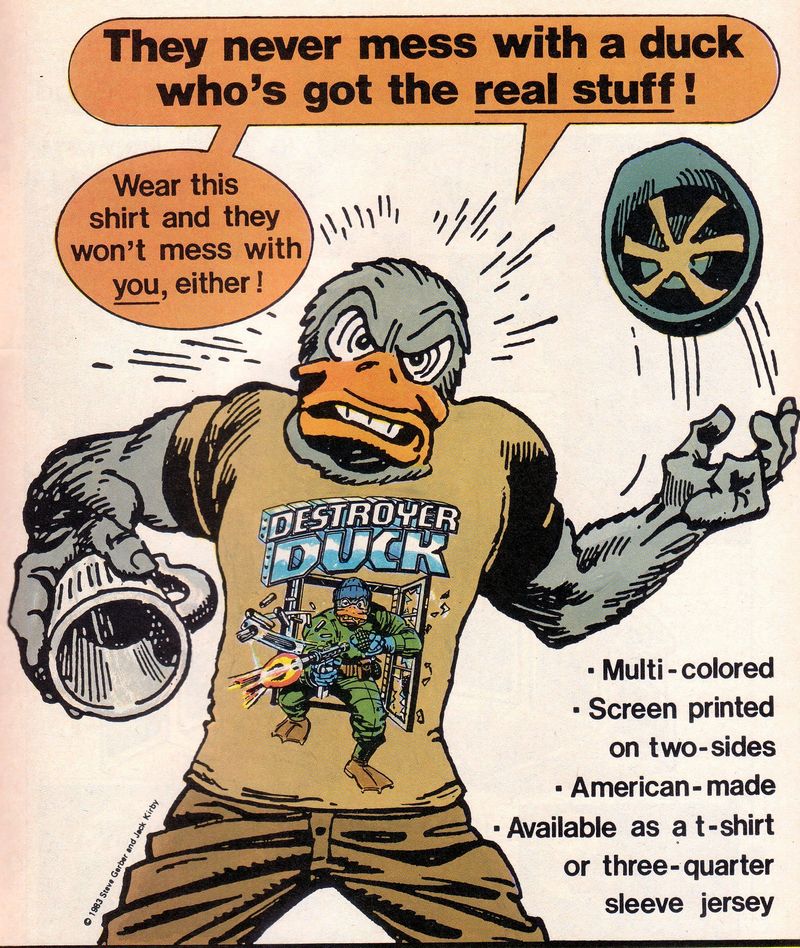
DESTROYER DUCK #1 opens with another Gerber text page, a memo from Ned Packer concerning "The Little Guy." The Little Guy, also known as "the duck," is a thinly-disguised Howard, but Gerber worded the memo in such an ambiguous way that it also refers to himself and Marvel's treatment of him:
"...The Little Guy, as per my previous memo, shall henceforth be accorded all the respect ordinarily reserved for unruly chattel. It, the duck, is our property, to do with as we see fit. All contracts entered into with the fowl are to be considered null and void. Its salary is to be discontinued. All communications from its attorneys are to be ignored."
The story, for Duke "Destroyer" Duck, a rugged, pugilistic construction worker, begins after work at Ginger's Joynt, where he's guzzling beer and grumbling about his beloved Dinah, who left him for a "sensitive wimp." His pal, the Little Guy, is forced to endure Duke's drunken rant and barroom brawling -- until he suddenly disappears! Duke is flabbergasted, and so are the other patrons.
But life goes on for Duke. He becomes a soldier, a scholar, and finally a cop. Relaxing one night with a bottle of booze (as per usual), the door swings open and the Little Guy staggers in with blood "spillin' out of his gut in puddles."
"I'm finished, Duke," the Little Guy gasps. "They opened me up...like a gunny sack...poked around inside...and never bothered...to sew me...back up..."
The Little Guy tells his story about how he vanished from this world into another world run by "pink primates," how, broke and starving, he signed a contract with Godcorp's Entertainment Concepts division, where he was exploited for his curiosity value and used and humiliated, until he hired a lawyer to get out of his contract. When he refused to call off the lawyer, his income was cut off and, finally, they sent him to their Medical Concepts division, where he was dissected like a frog and left on the table to die. The Little Guy explains that they opened him up to see what makes him tick, "so they could breed a less contentious talking duck...to sell as pets to little kids."
The Little Guy calls Godcorp "thugs...gangsters with expense accounts" and, in his dying breath, exhorts Duke to go to that world, find his lawyer, Holmes, and "make...'em pay."
His countenance grim, Duke mutters, "Rest easy, squirt. They'll pay."
Duke, impossibly resourceful, hops into a tiny spacecraft and flies from his dimension into ours, and ejects himself from the vehicle which then crashes into a bridge. Where he got this marvelous machine, how he knew where the interdimensional gateway to the offending world of pink apes was located, and why he let his only means of return explode into smithereens is all inexplicable -- but it hurries the story along.
We finally meet Ned Packer, president of Godcorp. On the wall behind his desk is a plaque bearing Godcorp's motto: "Grab it all, own it all, drain it all." The slogan was Kirby's invention. In a 1971 interview, Kirby complained: "If I did come up with an idea at Marvel, they'd take it away from me and I lost all association with it. I was never given credit for the writing which I did." Gerber says Kirby "handed me the pages and walked out. A few minutes later he came back in, and he found me on the floor laughing, with tears in my eyes. I looked up at him, and he smiled down at me and said, 'So, you like it?'" But Gerber wouldn't admit that Godcorp was Marvel. He wrote, "Godcorp wasn't any one company (unless Marvel has a nuclear weapons division I'm unaware of)."
A caption describes Ned Packer as a man who "has never had an idea in his life -- and he's proud of it. Like the unliving entity he captains, he exists to generate profit -- and ideas invariably interfere with the efficient pursuit of that objective."
"There were lots and lots of really nasty comments about the first issue," said Gerber, "starting, I suppose, with people who tried to find nasty things about themselves in the book. There were probably more people like Shooter, who weren't in the book but still managed to find themselves there." Jim Shooter was Marvel's editor-in-chief, and he was hoping to build the company into a Disney-like empire.
"Jim Shooter believed that [Ned Packer] was supposed to be him. The number of syllables is the same, and both surnames end in 'er.' But Ned Packer had nothing to do with Shooter...The Ned Packer character was really a caricature of corporate executives in general..."
When Duke is spotted in Manhattan, Ned Packer puts a hit on him. His own elderly mother, Vulpa Packer, is the would-be assassin, willing to do anything for a buck. "You're a junkie for your paycheck," says Ned. "And we have others whose 'drugs' are status, glamour, fame, power...The nature of the addiction doesn't matter...as long as Godcorp remains the connection. All of Godcorp's employees and freelancers are junkies, mother. We encourage that dependency relationship." (Obviously, Gerber had an extremely pessimistic view of the comics industry.)
The scene cuts to the Bowery Hills Hotel where the Little Guy's lawyer, Henry Holmes (named after Gerber's own lawyer), dressed in a superhero costume ("...an entertainment and copyright lawyer has to be prepared for anything"), pays a visit to Duke in his dingy room. He fills him in on the Little Guy's legal battle with Godcorp: "They fight all their battles with money, Duke. The entire staff of their Legal Concepts subsidiary was turned loose on us. They besieged us with motions, depositions, interrogations...! Imagine -- all the resources of a mammoth corporation marshalled against a single individual!" Duke interjects: "An' the rest happened all over my rug, huh?" "They're dangerous people, Duke -- very vindictive, very vicious. They hated the Little Guy because he stood up for himself."
Just then Vulpa Packer comes crashing through the window, wielding a battle-ax. "Die, Duck!! Die!" she roars as she attacks both Duke and Henry. Fortunately, the sack Duke carried with him on his mission contained his "favourite old war souvenir" -- a flame-thrower, which he uses to incinerate old Mrs. Packer.
Duke says he'll get "evidence" on Godcorp if Henry will take them to court.
"What evidence? How -- ?"
"Trust me again, Holmes. Ya don't wanna know."
"I suppose I can't stop you. Their address is listed in the phone book." Then, handing a set of keys to Duke, Henry says, "By the way...did you notice where I dropped the keys to my flying Ferrari...?"
"Keys? What keys?"
Duke attacks Godcorp, machine gun blazing, but is quickly defeated by Woblina Strangelegs, a green-haired lady whose unusual joints allow her limbs to move in impossible directions. When he wakes up, he finds himself strapped to a slab beneath a giant heavy metal press, which, Packer tells him, was originally manufactured for the sole purpose of pressing and cooking the Little Guy so that he could be served to him on a silver platter. "It's not enough to defeat the enemy. One must devour, digest and eliminate him." Ned offers Duke a "lucrative future" with his company. "You'd be foolish to throw away a promising career with Godcorp -- over a paltry matter of principle." Ned admires Duke's "killer instinct," a strength of character he found lacking in the Little Guy.
Duke, in fit of rage, tears free from his bindings. "Ya don't fool me -- ya don't scare me -- ya barely even interest me -- !"
"Y-you can't talk to me that way!" says Ned, cringing in fear.
Duke beats the snot out of him, throws him on the press and crushes him flatter than a pancake. The next night, he and Henry Holmes celebrate their victory at a ritzy restaurant. Raising a glass ("Cabernet Sauvignon '65. The duck's got taste."), Duke makes a toast: "...let's knock one back -- for the Little Guy, Holmes!"
But the first issue's adventure was only a battle. The war was yet to come.
Gerber says that the "reaction to the book in general, certainly from the fans, was very favourable." The comic sold well, "and it gave us enough money to continue the lawsuit and force the settlement."
The collaboration went smoothly. "I worked more closely with Jack than I had with most artists. For one thing, he was local. We got to see each other frequently. He was working for Ruby-Spears Productions at the same time I was, and that's when we did those books. Jack would come in a couple of times a week, and we'd sit and talk about the stuff. Occasionally, I'd drive out to his house, and see him and Roz."
Gerber, a lifelong fan of Kirby, was almost loath to admit that he'd found "the one object in the universe that Jack Kirby could not draw." "Here was a guy who not only could draw anything in the universe, he could draw whole universes! But for some reason, he could never get Destroyer Duck's beak right. Alfredo Alcala kept having to redraw it when he inked." Gerber, who had never worked with Kirby before, was intimidated by the speed at which the veteran worked. He mentioned "the terror of working with someone who could draw faster than I could write."
Instead of a full script, Gerber gave Kirby a detailed plot, usually 6 to 10 pages long. "I'd break it down page by page and in some instances by panels. Jack, being Jack, did whatever he felt he needed to with it. He added some things and dumped others. He adapted it to the way he draws...If Id wanted any other look, I'd have gone someplace else. What I got was exactly what I'd hoped to get -- a Jack Kirby comic book."
The fans may have enjoyed the Gerber/Kirby collaboration, but Gerber claims that Destroyer Duck didn't win him any friends amongst his peers. "All the negative stuff came from people in the industry. You have to understand, the comics business at that time was very much aligned with Marvel and DC. It's hard to conceive in this day and age, but most writers and artists at that time were vehemently opposed to the duck lawsuit and had very little sympathy for Jack and his situation with the artwork. They sincerely believed we were going to destroy the industry if we prevailed."
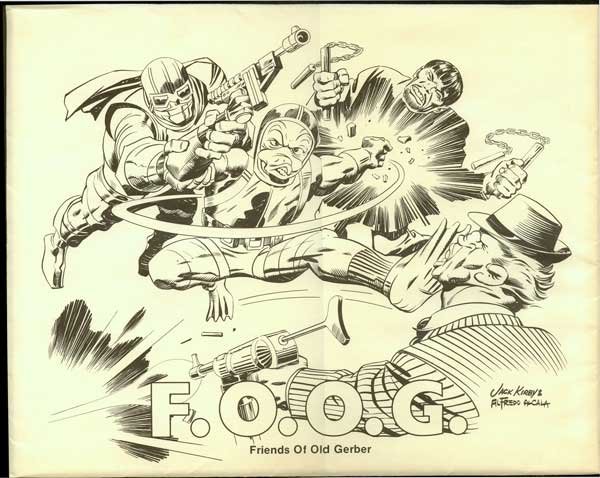
In 1982, Dave and Deni Sim published a portfolio called "F.O.O.G.", which stood for "Friends Of Old Gerber," to help raise funds for Gerber's legal battle. The project, which was initiated without Gerber's knowledge (he says he hadn't even met Dave and Deni Sim), featured 10 black and white plates (11" x 14") by Bernie Wrightson, Mike Kaluta, Charles Vess, Wendi Pini, Jeff Jones, Barry Smith, Marshall Rogers, Frank Thorne, Gene Colan, and Dave Sim, which came in a Duke "Destroyer" Duck envelope illustrated by Kirby and Alcala.
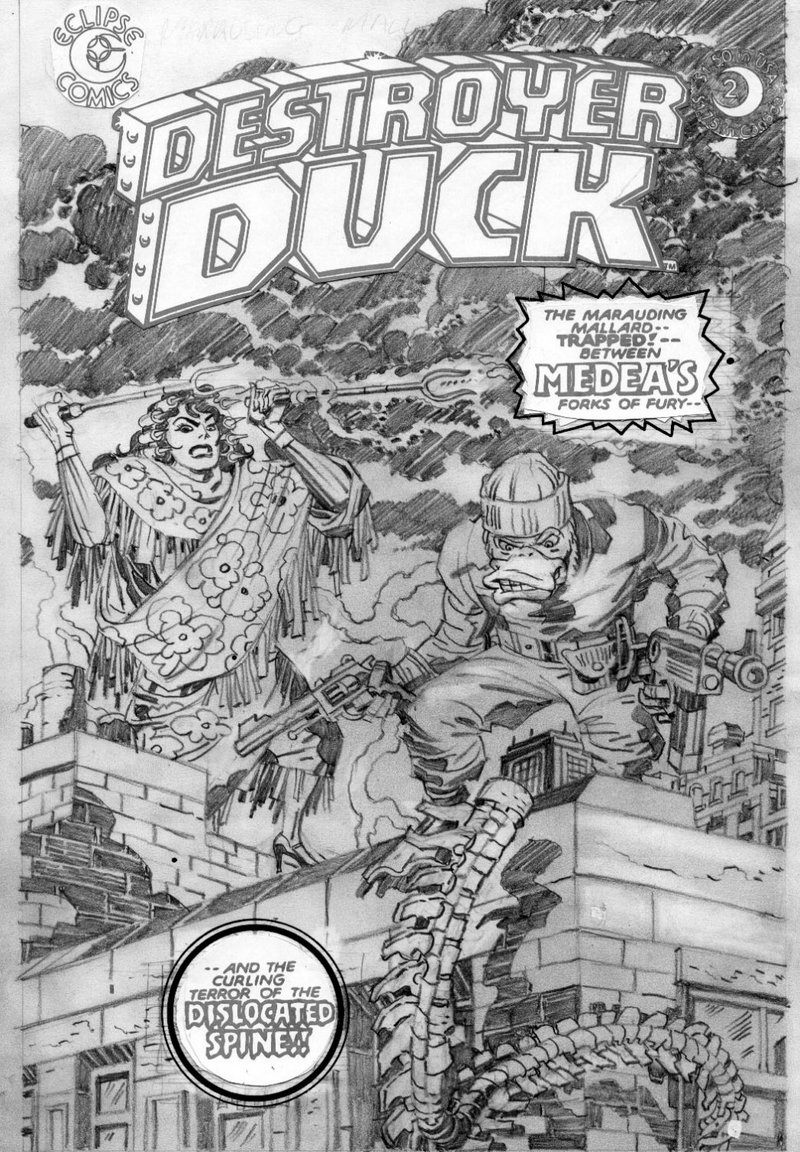
"It's a series," and so Duke was back for a 2nd issue -- which fans had to wait about eight months for! The story opens with Duke in the basement of his hotel working away at a "new nega-space transport for his journey home." He's attacked by a Mohawk-haired Uranus P. Chicago, wielding both gun and ice cream cone. Duke gets the better of him, and Uranus confesses he'd accepted this "job" from a woman named Medea, but only to impress actress Mariel Hemingway. (Uranus is a parody of TAXI DRIVER's Travis Bickle character, and John Hinckley, who attempted to assassinate U.S. President Ronald Reagan to get the attention of actress Jodi Foster.) Medea, he's told, works for Enforcement Concepts, Ltd., a division of Godcorp.
Next we meet the unforgettable Booster Cogburn, who has just delivered an illegal arms shipment to General Abuuk in the Middle Eastern country of Hoqoom. The general asks Cogburn how he feels about Godcorp's association with his organization. "I'm a company man, general. I'm not paid to have opinions." Cogburn continues, "Personally, I figure all you terrorist-types for pissant cowards. You wanna kill a guy -- have the guts to shoot him in the face! Don't bomb his house and skag his wife and babies, too -- y'follow?"
"Perfectly," says Abuuk. "Shoot him in the face."
Three soldiers machine gun Cogburn, and he falls off the roof of the 23 storey building, his bullet-riddled body landing head first in the narrow alley below. A minute later, his entire spinal column tears free from his body, ripping through flesh and cloth. It slithers away like a snake.
The fans suspected that Booster Cogburn was a parody of artist John Byrne, and Gerber admitted as much. The character was inspired by something Byrne said in an interview, "in which he described himself as a 'company man' and told the world how happy he was functioning as a cog in the Marvel corporate machine." The name was a triple pun: "cog" and "Byrne," and the John Wayne character, "Rooster Cogburn." And then of course there's Cogburn's spinelessness -- but Gerber said that he and Byrne had "shaken hands and made up since then."
Getting back to the story, at the offices of Henry Holmes, "Destroyer Lawyer" informs Duke that Medea Souvlakis was a child-murderer, having stabbed both of her children to death with barbecue forks. "She pleaded diminished capacity -- claimed that her mental faculties were impaired from eating the kids' sugar-coated cereals. The jury in California believed her. She got off with two years in a mental hospital." The case is entirely believable, so Duke doesn't even wince.
Duke appreciates Holmes's generosity, but he tells him he'd like to start earning a living. "Don't be ridiculous, Duke -- you're a duck! You're unemployable in this space-time continuum!" But Duke insists, and, as he leaves, Holmes advises him, "And Duke, before you apply for a job -- go home and change your personality."
In the elevator, Duke is attacked by Medea, who refers to herself as "Mommie." The quiver strapped to her back is loaded with barbecue forks, and when their battle spills out into the lobby Duke throws one of her forks back at her. "My pop always said: 'Sticks an' stones can mash yer bones -- so be sure you got the sticks and stones!'"
Medea kills two police officers with her unusual choice of weapons. Duke is appalled by her callousness.
"Awww! Did Mommie give you a fright?" coos Medea. "Poor widdle duck looks like he messed his pants! Come along, now -- and Mommie will fix you all up!"
But Duke doesn't need his diaper changed, so the battle wages in the middle of the street, and, despite Duke's punches, Medea manages to stick a fork in his back, and makes her escape. (It should be noted that Medea, too, was a parody, this time of Frank Miller's Elektra.)
The 2nd issue included a backup feature, "The Starling," written by Superman co-creator Jerry Siegel, who, along with artist Joe Shuster, had also had his own legal battles with DC comics over ownership of the Man of Steel. They didn't establish ownership of the character, but they were granted some remuneration in the form of a pension, meagre though it was, and credit for their creation.
In issue #3, Duke, who was presumed dead, wakes up in a body bag -- in a truck full of caged animals -- and tears himself free. A Doberman freaks out and bursts through his cage, and when it launches itself on Duke they both crash through the back door onto the street. The duck barely escapes the dog's slavering jaws when he scrambles up a fire escape. He sees an open window.
"Nothing moving inside," he notes mentally. He leaps into the apartment and, with the negativeness usual found in Gerber's characters, says "Tenant's probably out robbing somebody."
Duke discovers that the apartment is full of novelty telephones, including a Mickey Mouse phone that reminds him of someone he knows back home named Milton. The bathroom door opens and a scarecrow of a man emerges: "Beryl? Is that you? I was voiding?" Too much information. Brad White, phone company employee, introduces himself.
"Uh, Brad...there's a corporation and a dog on my tail. I need to lay low for a while..."
"You came to the right place, Duke. Nobody knows I'm alive. They'll never find you here." Beryl Mudge, whom Brad is infatuated with, lives upstairs. He'd just bought her a new phone (employee discount) "'cause she's like my very own Vanilla Cupcake."
Duke utters a double-entendre: "Yeah? Personally, I'm partial to tarts."
But Vanilla Cupcake, we learn, isn't exactly a pastry. Vanilla Cupcake is a child working for Mead Packer's Leisure division of Godcorp, and her likeness is used to market every conceivable product. When in character she was more charming and saccharin than Shirley Temple, but otherwise she resented her role as a living doll and would throw tantrums.
When Brad goes to Beryl's apartment to proffer his gift of a Vanilla Cupcake phone she punches him in the face and slams the door. Duke, whose violence, temper and decorum make Howard seem like a perfect gentleman, breaks open the door to demand an explanation. Beryl, who thinks he was sent by Godcorp, is holding her ground -- and a grenade. But Duke and Brad assure her they're on the same side.
Beryl explains that Vanilla Cupcake is her little sister and that she goes berserk when she sees images of her. Beryl was born with unusually attractive pheromones which made her smell like cherries and made everyone fawn over her. She was smothered by everyone's affection and adulation. When her sister, Opal, was born, she smelled like Vanilla. Their mother signed a 10-year contract with Godcorp, who wanted to exploit them as a sister act, Cherries Jubilee and Vanilla Cupcake, to help promote a line of toys scented with a diluted version of their pheromones. Unfortunately, the constant tapping of their glands was a painful procedure. Beryl managed to escape.
"And my sister will be free," she promises, "or certain persons will be dead." Beryl asks Duke to join forces with her. Duke has "nothing to lose by taking the offensive," so he's in. Brad reluctantly agrees to tag along. Beryl dubs herself "Cherries Jubilee" and dons a costume: thigh boots, fishnet stockings, a t-shirt -- and a round, red helmet. Duke was armed to the teeth, but Cherries, too, had her resources: cherry bombs that could "flambee a human being," and a cherry jawbreaker on a chain that was "five pounds of solid iron."
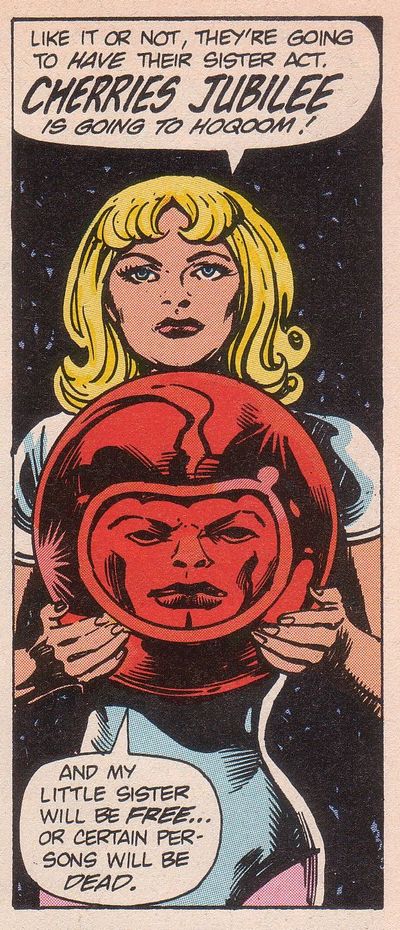
Gerber was aware that Cherries Jubilee looked like his other character, Ruby, from the Headmen, but he offered a glib defense: "Beryl's helmet pretty much had to be round and red. A character called 'Cherries Jubilee' with a green cube on her head wouldn't have made much sense."
Howard may have been cantankerous, but Duke was practically homicidal. Gerber offered some perspective: "[B]ear in mind that Duke is a character, not a role model." Still, Duke, Cherries, Brad, Vanilla Cupcake, Cogburn, Medea, and Woblina Strangelegs, as well as others, were all original, interesting and unforgettable characters. DESTROYER DUCK should have gone on for a few years -- but it wasn't to be. The Godcorp story was wrapped up with issue #5, at which point both Gerber and Kirby left the strip. It was continued by writer Buzz Dixon, who worked with Gerber for years in animation, but the series only lasted for two more issues.
It's hard to imagine that the real Henry Holmes would have wanted "Destroyer Lawyer" to continue indefinitely as a comic book character. But his repartee during battle was interesting. "Not another move, pending arrest, my friend! You've been caught flagrante delicto!" he says while stomping on a Cogburn's head. Even the sound effects of his punches are obscure legal terms.
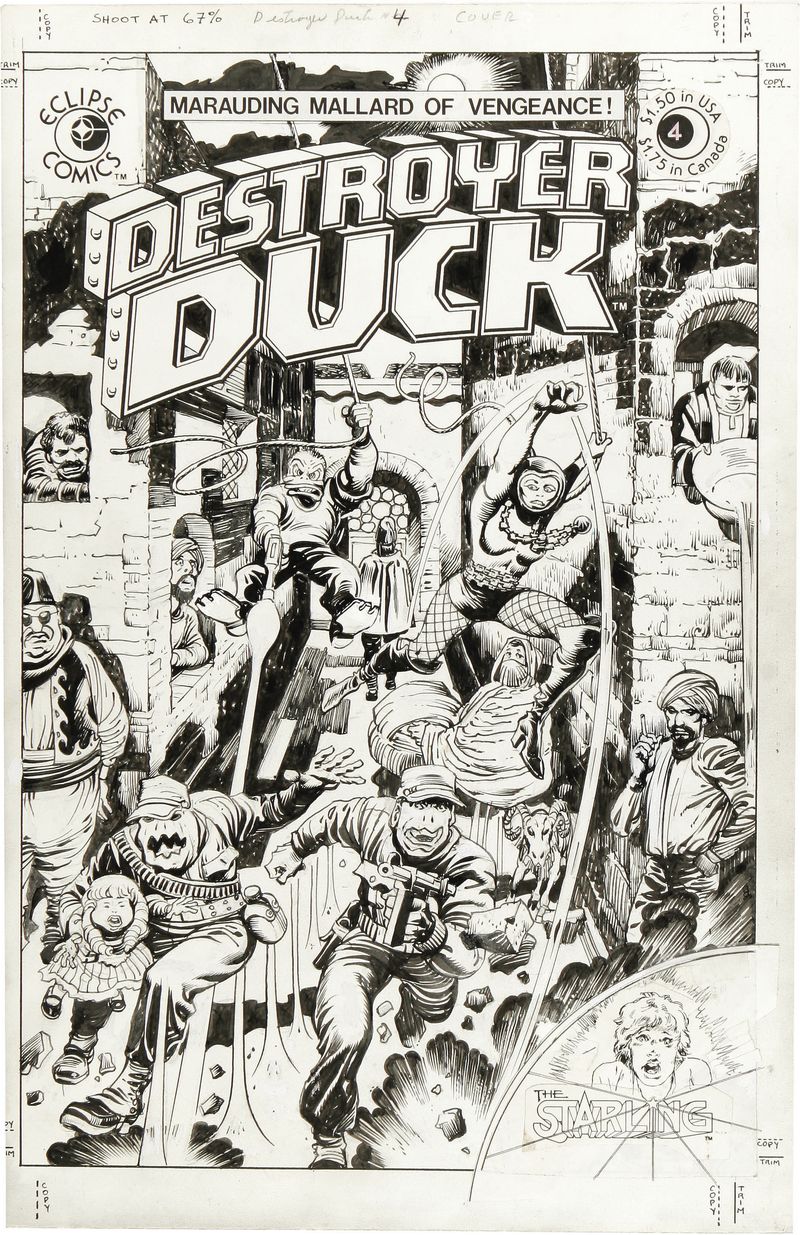
Eventually, Gerber's lawsuit against Marvel ended with a settlement. "It took three years of my life and $140,000 to pursue. Some of that, thank heavens, was offset by the two dozen or so people in the industry I can still look straight in the eye, Jack among them." According to Gerber, the proceeds from the first issue of DESTROYER DUCK and the F.O.O.G. portfolio "covered 20%, possibly a little more, of the lawsuit."
"We fought it all the way to within two weeks of actually going to court. We were prepared to go into court, and at the last moment we were able to reach a settlement which I thought was fair and equitable, and in many ways less chancy than going to court with something like this. A decision against me, which was possible, would've done a great deal of harm not only to me, but to other people who might have to sue another comics publisher or the same publisher on the same basis. I didn't want to take that risk. The trial alone would've cost another $25,000, and I could've gotten stuck with some of Marvel's legal fees after that."
Before accepting the settlement, Gerber consulted Jack Kirby and Jerry Siegel. "I wanted to be sure they would understand my not taking the suit all the way to the Supreme Court, had it been necessary. Both of them encouraged me to settle as long as I felt the terms were fair."
Gerber claimed he'd won a "legal victory," but the duck still wasn't his, and Marvel also retained creative control over the character. "Marvel owns a character named 'Howard the Duck,' and I don't. Nor do I have any rights to use a character named 'Howard the Duck'. Those are the concessions I made to Marvel to settle the suit. Marvel made certain concessions to me, as well, but at Marvel's insistence, I agreed that the exact terms of the settlement would remain confidential."
Gerber often repeated that he thought the settlement "fair and equitable," but he was less than satisfied with the outcome. "Did I really believe Marvel had established ownership of Howard from the character's inception? No." At the very least, Marvel was required to give him a "created by" credit whenever they used the character.
Gerber kept looking back at the settlement with increasing pessimism as the years went by. "Creators' rights? Creator royalties? The overall treatment of writers and artists? Sure, those seemed important -- but only briefly. In a market that's incapable of selling anything other than company-owned superheroes in any significant quantity, what do they really mean?"
Gerber was aware that fans wondered whether or not he'd sold out. "I am perfectly willing to talk about it any time Marvel says it doesn't have to be confidential anymore. Let them drop me a note as soon as they're willing to say that and I'll go on national television if you want and gladly say exactly what it is. But at their request it was a condition of being able to settle the suit. I had to agree to that."
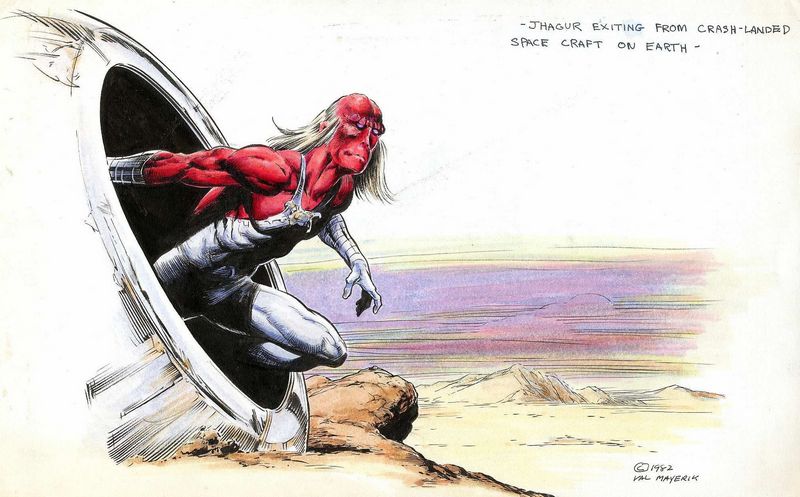
About a year later Gerber was back at Marvel, this time with a new series, VOID INDIGO, created with artist Val Mayerik, for which they retained both copyright and trademark. But this "crime against humanity," as one reviewer called it, was scuttled in mid-voyage. It was cancelled after the 2nd issue.
"After they saw the first issue of what was supposed to be the ongoing series, a number of distributors urged their retailers to boycott the book," said Gerber. "It was literally boycotted out of existence..."
The graphic novel that preceded the series contained some disturbing scenes of torture which, for the victim, lasted several days, and this was after being forced to watch his lover tortured all night long before being put out of her misery. This "Penny Dreadful" became more interesting and palatable in the first two issues of the comic book -- but one wonders if Gerber could have devised a less gruesome reason for his protagonist to seek revenge. (It's hard to imagine that VOID INDIGO "was originally developed as a revamp of Hawkman" for DC.)
Gerber said that the comic "was simply a few years ahead of its time. The level of violence, the treatment of sex and sexual ambiguity, were unheard of in mainstream comics at the time."
He also suggested that it wasn't the violence or the sexuality itself that was offensive, but the way in which these subjects were treated. "VOID INDIGO may have been very strong stuff for mainstream comics, but there were certainly more sexually explicit and violent stories in the undergrounds. For sexual explicitness, VOID INDIGO pales beside some of Robert Crumb's work, and Richard Corben and others had approached or exceeded it in terms of graphic violence, too. Crumb's work, though, always had that mad, cartoony quality that put a bit of psychological distance between the reader and what was happening on the page. Corben's stories tended to be set in fantasy worlds and peopled with characters that were larger than life, heroically and anatomically. By contrast, VOID INDIGO was set in the present, illustrated in a more or less realistic style, and, except for the alien protagonist, the characters were people you might meet on the street, in a bar, or at the supermarket. That made it scary, and made the sexuality real and disturbing, in a way that the undergrounds hadn't been."
Sales dropped from 80,000 copies on the first issue to 14,000 on the second issue. Gerber must have been getting used to these disappointments. "Archie Goodwin, who was editing the book, felt it wasn't worth continuing the series, and reluctantly I had to agree."
A detailed synopsis of the rest of the series, issues 3-6, exists, and Gerber had hoped that one day he could finish it "even if I have to publish it myself." Self-publishing seemed to be his only likely recourse. "Even now, no publisher wants to go near it." Indeed, the series was "tainted" by an "overblown controversy."
Gerber's next effort for Marvel was a Howard the Duck script. "After the settlement, Marvel approached me about reviving Howard the Duck. I enthusiastically set about writing the script for a new first issue of the series. The script came back to me from Marvel with large chunks deleted and/or changed by the company's then-editor-in-chief. In light of the mauling the script suffered, I didn't want it published. I 'pulled' it, and that was the end of the Howard the Duck revival."
The problem was Gerber's insistence that only the issues he had written of HOWARD THE DUCK were canon. Everything else was apocryphal. "I wanted to pick up HOWARD as I left it. Now, I realised I couldn't do that without making some kind of accommodation to the continuity that had been established in the meantime, so I tried to do that. I had written a story which reconciled the continuity from the black and white books with the end of the continuity from the colour books I had done..."
Basically, Gerber "reconciled the continuity" by saying that none of it had happened! And most of it shouldn't have happened. "In the original series," said Gerber, "I never showed or even named the world Howard came from. I always felt it was more interesting to let readers imagine it for themselves." As it turns out, Duckworld and Howard's post-Gerber adventures were the invention of a young lady named Chirreep, a "techno-artist in exile" on the planet Krylor. Her "poporb" device allows her to make her own "movies" based on real living beings from somewhere in the multiverse, in this case, Howard the Duck. The stories in the black and white magazine were her fictions. (This is a simplification of a more complex situation.) Jim Shooter felt "that what this constituted was, in effect, a slap in the face to the other writers...and they [Marvel] didn't want to insult them and so they would not publish the story as it was written."
Upon reflection, years later, Gerber was more cynical: "I strongly suspect that Marvel would have rejected anything I turned in. They didn't want me working there again, and they especially didn't like the idea of a creator who sued the company returning to his creation."
The story was submitted April 11, 1985. It would be another few years before Gerber would write for Marvel again.
The picture of Gerber with Dean Mullaney at the 1982 San Diego Comic Con is courtesy of Alan Light.